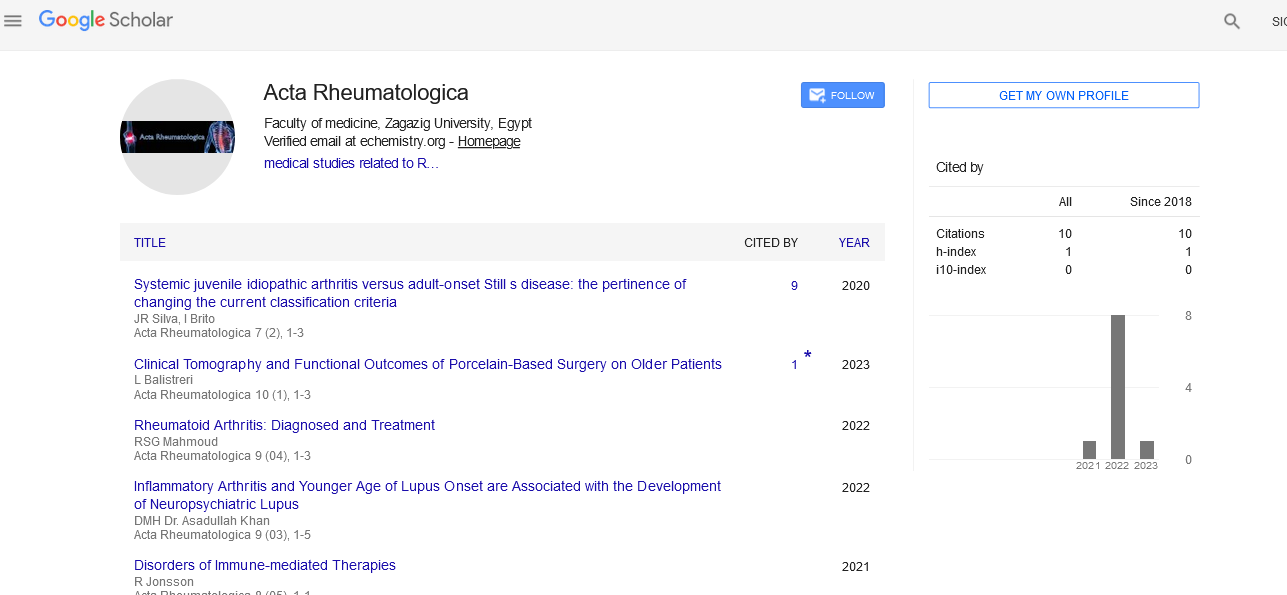Perspective - (2025) Volume 12, Issue 1
Advances in Imaging Technologies for Diagnosing Rheumatic Diseases
Georges Simenon*
Department of Health Care, Flanders Business School, Antwerp, Belgium
*Correspondence:
Georges Simenon, Department of Health Care, Flanders Business School, Antwerp,
Belgium,
Email:
Received: 03-Feb-2025, Manuscript No. IPAR-25-15551;
Editor assigned: 06-Feb-2025, Pre QC No. IPAR-25-15551 (PQ);
Reviewed: 21-Feb-2025, QC No. IPAR-25-15551;
Revised: 03-Mar-2025, Manuscript No. IPAR-25-15551 (R);
Published:
12-Mar-2025
Introduction
Rheumatic diseases encompass a wide range of conditions
characterized by inflammation and pain in the joints, muscles,
and connective tissues. Accurate and timely diagnosis is crucial
for effective treatment and management, as many of these
conditions can lead to significant morbidity if left untreated.
Recent advancements in imaging technologies have transformed
the diagnostic landscape for rheumatic diseases, enabling
healthcare professionals to identify abnormalities with greater
precision and efficiency. This article explores the latest
developments in imaging techniques and their implications for
diagnosing rheumatic diseases.
The importance of imaging in rheumatic diseases
Imaging plays a vital role in diagnosing rheumatic diseases, as
it allows for visualization of internal structures, assessment of
inflammation, and evaluation of joint integrity. Traditional
imaging modalities, such as X-rays, have long been used to
identify joint damage and erosions. However, newer technologies
offer enhanced capabilities, providing more detailed information
about the underlying pathology.
Description
Magnetic Resonance Imaging (MRI)
MRI has emerged as a cornerstone in the diagnosis of
rheumatic diseases due to its superior soft tissue contrast
and ability to visualize both bone and cartilage. Recent
advances in MRI techniques include:
High-resolution imaging: Innovations in MRI technology, such
as higher magnetic field strengths (3T and above), allow for
improved image quality and resolution. This is particularly
beneficial for detecting early signs of joint inflammation and
damage, such as bone marrow edema and synovitis.
Dynamic contrast-enhanced MRI: This technique involves the
injection of a contrast agent to assess the perfusion of
synovial tissue. It provides insights into the vascularity of
inflamed tissues, helping to differentiate between active
inflammation and chronic changes.
Quantitative MRI: New quantitative methods enable the
assessment of cartilage thickness and joint space, providing
objective measurements that can help track disease progression
over time.
Ultrasound (US)
Ultrasound has gained popularity in rheumatology due to its
accessibility, real-time imaging capabilities, and ability to guide
interventions. Recent advancements include:
Power Doppler ultrasound: This technique enhances the
visualization of blood flow, allowing for the detection of synovial
hyperemia and active inflammation. It is particularly useful in
assessing conditions like Rheumatoid Arthritis (RA) and Psoriatic
Arthritis (PsA).
3D ultrasound: Three-dimensional imaging provides a
comprehensive view of joint structures, improving the accuracy
of assessments and enabling better treatment planning.
Portable ultrasound devices: The development of handheld
ultrasound devices has made it easier for rheumatologists to
perform bedside assessments, facilitating timely diagnosis and
management.
Computed Tomography (CT)
CT scans are useful in assessing bone changes and complex
joint structures. Recent improvements include:
Low-dose CT: Advances in imaging technology have allowed
for lower radiation doses without compromising image quality.
This is particularly important for patients requiring multiple
scans over time.
CT arthrography: This technique involves the injection of
contrast material into the joint space, allowing for better
visualization of intra-articular structures. It is beneficial for
diagnosing conditions such as labral tears and other intra-articular
abnormalities.
Positron Emission Tomography (PET)
PET imaging is not routinely used for diagnosing rheumatic
diseases, but recent developments have shown promise in
evaluating inflammation:
Fluorodeoxyglucose (FDG) PET: This technique assesses
metabolic activity in tissues and can help identify areas of active
inflammation. Although primarily used in oncology, it is gaining
traction in rheumatology for assessing disease activity and
treatment response.
Integrating imaging technologies into clinical
practice
The integration of advanced imaging technologies into clinical
practice requires a collaborative approach among rheumatologists,
radiologists, and other healthcare professionals. Key considerations
include:
Standardization of protocols: To ensure the reliability and
comparability of imaging results, standardization of imaging
protocols is essential. This includes the use of consistent
techniques, patient positioning, and imaging parameters.
Training and education: Healthcare professionals must
receive appropriate training in the interpretation of advanced
imaging modalities. Ongoing education and collaboration with
radiologists can enhance diagnostic accuracy and improve
patient outcomes.
Multidisciplinary collaboration: A multidisciplinary approach
is crucial for effective diagnosis and management. Collaboration
among rheumatologists, radiologists, and other specialists can
facilitate comprehensive patient care and streamline the
diagnostic process.
Challenges and future directions
Despite the advancements in imaging technologies, several
challenges remain:
Cost and accessibility: Advanced imaging techniques can be
costly and may not be readily available in all healthcare settings.
Addressing these barriers is essential to ensure equitable access
to these diagnostic tools.
Over diagnosis and overtreatment: The sensitivity of advanced
imaging techniques can sometimes lead to over diagnosis or the
detection of clinically insignificant abnormalities. Clinicians must
balance the benefits of early detection with the risks of
unnecessary interventions.
Continued research and innovation: Ongoing research is
essential to refine existing imaging technologies and develop
new modalities. Innovations such as Artificial Intelligence (AI) in
image analysis hold promise for enhancing diagnostic accuracy
and efficiency.
Conclusion
Advancements in imaging technologies have significantly
transformed the diagnosis of rheumatic diseases, providing
healthcare professionals with powerful tools to visualize
inflammation, assess joint integrity, and monitor disease
progression. Techniques such as MRI, ultrasound, CT, and PET
have expanded our understanding of these complex conditions
and improved patient outcomes. As the field continues to
evolve, integrating these technologies into clinical practice will
require ongoing education, collaboration, and a commitment to
addressing existing challenges. Ultimately, these advancements
will play a pivotal role in enhancing the quality of care for
patients with rheumatic diseases, paving the way for more
precise and personalized treatment approaches.





